Eisenhower, Dwight David (1890-1969), leader of the victorious Allied forces in Europe in World War II, rode a wave of popularity as a war hero to become president of the United States. Eisenhower had more than 30 years of military experience when he was elected chief executive in 1952, but he was remarkably unmilitary as president. Good leadership, he believed, was not a matter of issuing orders and enforcing obedience. Instead, an effective leader inspired others to cooperate and to use their own talents to the fullest.
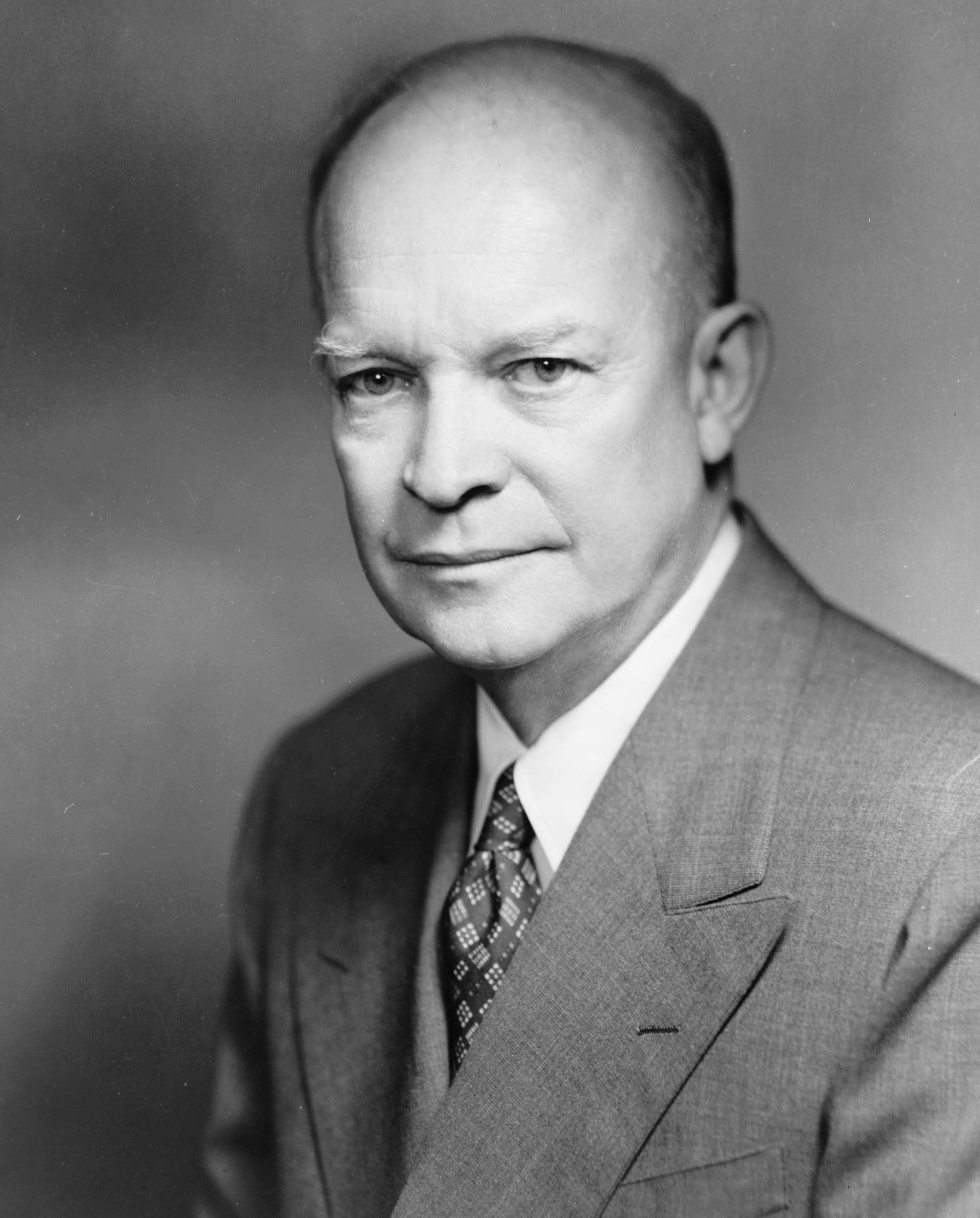
Eisenhower was an organized, thoughtful, and patient executive. People throughout the world loved the tall, baldheaded man they fondly called “Ike.” His broad grin and friendly manner could put almost anyone at ease.
As president, Eisenhower faced many hard decisions. At home, fear of Communist influence in government led to widespread loyalty investigations. New civil rights issues aroused bitter disputes. In foreign affairs, Communist threats in Asia, Africa, and Latin America caused a series of crises. Eisenhower made little progress in reducing international tensions, yet the soldier in the White House helped keep the world at peace.
Early life
Boyhood.
David Dwight Eisenhower—who was always called Dwight David—was born on Oct. 14, 1890, in Denison, Texas. His parents were David Jacob Eisenhower and Ida Stover Eisenhower, a deeply religious couple who belonged to a Protestant sect called the River Brethren. Dwight had two older brothers, Arthur (1886-1958) and Edgar (1889-1971), and three younger ones—Roy (1892-1942), Earl (1898-1968), and Milton (1899-1985). Another brother died as an infant. Dwight’s parents were descended from German and Swiss immigrants who had come to Pennsylvania in the 1700’s.
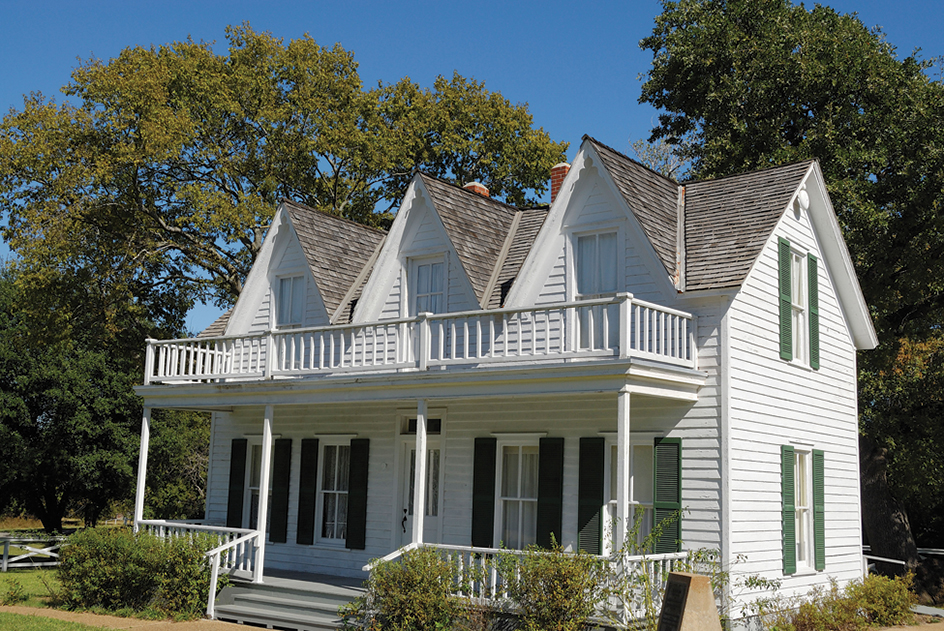
When Dwight was still a baby, his family moved to Abilene, Kans. Dwight’s father worked in a creamery. The sons raised and sold vegetables and found a variety of other jobs to contribute to household expenses.
Dwight was popular with his classmates, who gave him the nickname “Little Ike” to distinguish him from “Big Ike,” his brother Edgar. Both Dwight and Edgar impressed their fellow students. Predictions that appeared in their high school yearbook saw Dwight becoming a history professor and Edgar, interestingly, president of the United States.
West Point cadet.
After high school, Dwight worked full-time at the creamery and helped pay Edgar’s first-year college expenses. Dwight had no prospects for his own higher education until a friend persuaded him to apply to the national military academies, where tuition is free. Senator Joseph Bristow of Kansas got Eisenhower an appointment to the U.S. Military Academy at West Point, N.Y. Although Eisenhower chose the career of a soldier, he respected his parents’ opposition to war. He considered military service an opportunity for learning and discipline.
Eisenhower played on the football team at West Point. But a knee injury ended his hopes of being a star halfback and forced him to quit the team. In 1915, Eisenhower graduated 61st in a class of 164. The Army assigned the new second lieutenant to Fort Sam Houston, near San Antonio.
Eisenhower the soldier
Eisenhower’s family.
While off duty at Fort Sam Houston, Eisenhower coached sports teams. He also met Mamie Geneva Doud (1896-1979), a visitor from Denver, and started to take her to social gatherings at the base. On July 1, 1916, the day of his promotion to first lieutenant, Dwight and Mamie were married.
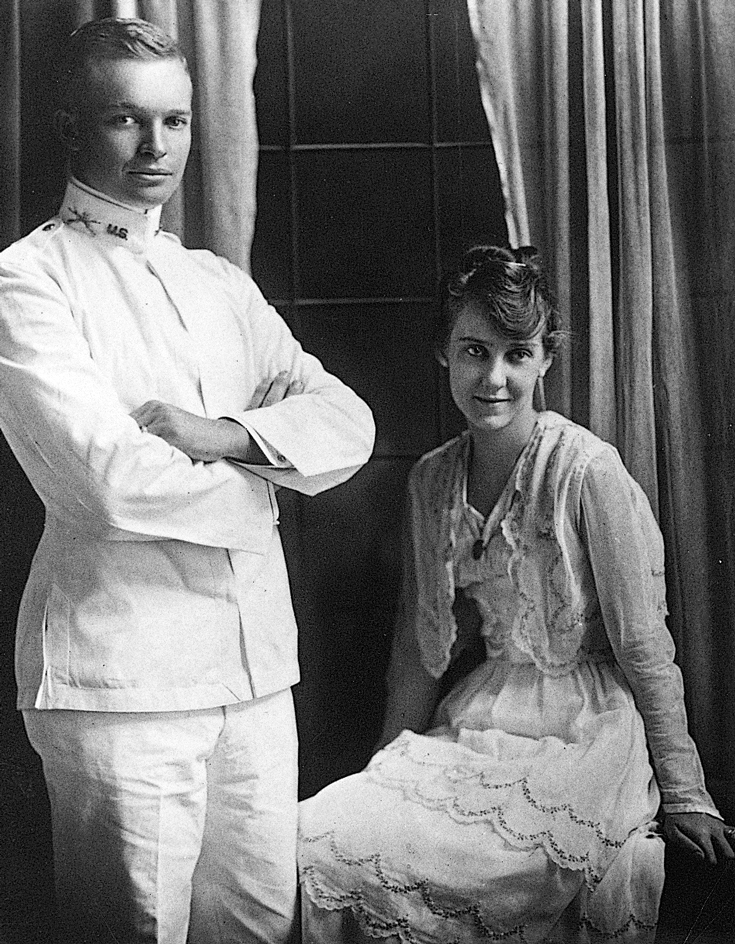
The young couple’s first son, Doud Dwight Eisenhower, died of scarlet fever at the age of 3. The Eisenhowers had a second son, John Sheldon Doud Eisenhower (1922-2013), who became an Army officer and diplomat. In 1968, John’s son, David, married Julie Nixon, the younger daughter of Dwight Eisenhower’s vice president, Richard M. Nixon.
Early military career.
Like most military families, the Eisenhowers continually moved from one Army post to another. Eisenhower directed tank training programs for officers and recruits at Camp Colt, in Gettysburg, Pennsylvania, during World War I (1914-1918).
After World War I ended, Eisenhower served on the staff of Brigadier General Fox Conner in the Panama Canal Zone, a strip of land surrounding the Panama Canal then governed by the United States. Conner greatly influenced Eisenhower. The young officer was especially impressed by Conner’s self-discipline and attention to detail.
Conner supported Eisenhower’s admission to the Army’s “leadership factory,” the Command and General Staff School at Fort Leavenworth, Kansas. In 1926, Eisenhower graduated first in his class of 275 top Army officers who survived the highly demanding training in tactics and other military skills.
MacArthur’s aide.
Eisenhower held various posts during the next few years. In 1933, he became an aide to General Douglas MacArthur, the Army chief of staff, in Washington, D.C. In 1935, MacArthur became military adviser to the Commonwealth of the Philippines, a U.S. possession since 1898. He took Eisenhower with him to the Asian country, which was being prepared for independence. Eisenhower planned the military defense of the Philippines and a military academy for the new government. He took flying lessons in the Philippines and made a solo flight in 1937, when he was 47 years old.
Rise to prominence.
World War II began in 1939. Germany—later joined by Italy, Japan, and other Axis powers—fought the Allies, which included the United Kingdom, France, and later the Soviet Union and the United States. In 1940, the United States began to build up its military forces in case it was drawn into the war. In 1941, the Army appointed Eisenhower to plan the strategy for the Third Army in war games in Louisiana. The Third Army brilliantly defeated an “enemy” force that included a tank division commanded by Eisenhower’s friend George S. Patton, Jr., who also became a World War II hero. Eisenhower’s performance earned him a promotion to brigadier general in September 1941. He also caught the attention of General George C. Marshall, who had replaced MacArthur as Army chief of staff.
The United States entered the war in December 1941, after Japan attacked the U.S. naval base at Pearl Harbor, Hawaii. Marshall brought Eisenhower to Washington, D.C., to serve in the Army’s war plans division. Eisenhower was promoted to major general in March 1942. In June 1942, he was named commanding general of U.S. forces in the European Theater of Operations. He had been advanced over numerous eligible senior officers.
Eisenhower became a lieutenant general in July 1942. He also was named commander of Allied forces organized to invade North Africa. The invasion began in November 1942 and resulted in the recapture of the region from German and Italian forces. In February 1943, Eisenhower was promoted to the rank of four-star general, then highest in the Army. He organized the Allied invasions of Sicily in July 1943 and of Italy in September 1943. In all these campaigns, he worked to create unity among commanders from different nations. Many of these commanders were stubborn and outspoken, and Eisenhower had to be as much a diplomat as a planner.
Operation Overlord.
In 1943, the United States and the United Kingdom set up a combined staff to plan the Allied invasion of German-occupied Europe. Marshall and Eisenhower were both highly recommended to organize the invasion. But U.S. President Franklin D. Roosevelt did not want Marshall to leave his vital work in Washington. In December 1943, Roosevelt named Eisenhower supreme commander of the Allied Expeditionary Force in Europe.
The Allies planned to cross the English Channel in early June 1944 and to invade Normandy, in northern France. The plan was called Operation Overlord, and it was the largest seaborne invasion in history.
Eisenhower set up headquarters near London and began the enormous responsibility and task of planning the invasion. He had to coordinate the armies and navies of the United States, the United Kingdom, and the other Allies to ensure that they worked smoothly as one force.
The success of Operation Overlord depended on low tides and calm seas for the landing boats, and clear skies for the bombers protecting them. But on June 3, the weather turned bad, with rough seas and heavy clouds. Weather experts told Eisenhower there was a slim chance that the weather would clear up on June 6. If the invasion did not begin that day, it would have to wait two weeks until the next low tide. 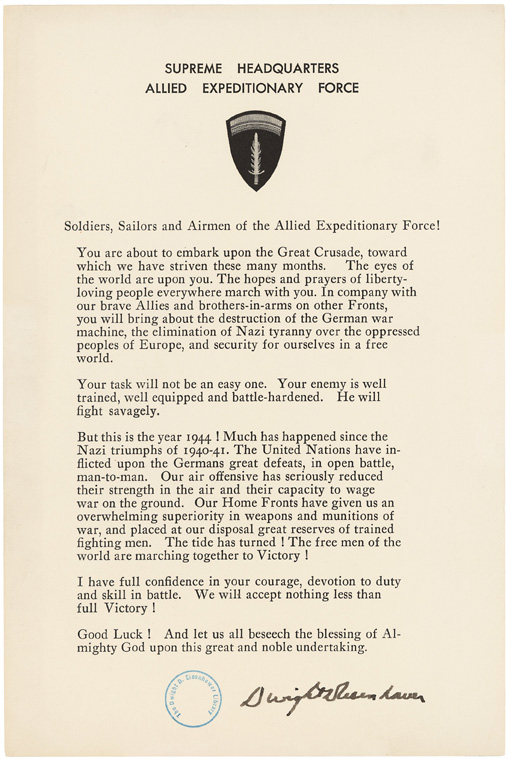
Eisenhower faced the anguish of decision. He could risk millions of lives on the small chance of good weather, or he could delay the landing and probably lose the vital military element of surprise. On June 5, Eisenhower made his final decision. “OK, let’s go!” he ordered. The invasion began early in the morning of June 6, 1944, a day that became known as D-Day. By nightfall, the Allies had a firm hold on the beaches of Normandy. After 11 more months of bloody fighting, Germany surrendered on May 7, 1945.
Chief of staff.
Eisenhower had received the newly created rank of five-star general in December 1944. A hero’s welcome awaited him on his return to the United States in June 1945. He wanted to retire from the military and find a quiet civilian position. However, the nation still needed his services and, in November 1945, he replaced Marshall as Army chief of staff. Loading the player...
Dwight Eisenhower
Eisenhower argued for a slow disbanding of U.S. armed forces to keep the nation strong. He also wanted to draft all 18-year-old men for one year. But this proposal attracted little support in a nation anxious to return to peacetime life.
Eisenhower also urged that the armed services be unified under a single command. But many military and political leaders opposed such a merger. In 1947, Congress passed a compromise measure unifying the U.S. armed forces under a single secretary of defense.
NATO commander.
In 1948, Eisenhower retired from active military service to become president of Columbia University in New York City. He wrote a book about his wartime experiences, Crusade in Europe (1948), and was surprised when it became a best seller.
Eisenhower was soon back in uniform. During the late 1940’s, Soviet-controlled Communist governments were established in most countries of Eastern Europe. As a result, the United States and Canada joined several Western European nations in 1949 to form a military alliance called the North Atlantic Treaty Organization (NATO). In 1950, President Harry S. Truman asked Eisenhower to become supreme commander of NATO forces in Europe, which were made up of troops from the member nations. Eisenhower eagerly accepted the job of molding this unique international army.
Road to the White House
Presidential candidate.
Eisenhower became involved in politics partly as a result of deep divisions that developed in the United States over the Korean War. The war had begun in June 1950, when troops from Communist North Korea, equipped by the Soviet Union, invaded South Korea. Truman sent American troops to aid South Korea as part of a United Nations (UN) fighting force. Many Republicans supported U.S. participation. But a group of conservative Republicans led by Senator Robert A. Taft of Ohio wanted the United States to withdraw from the war, which had quickly become a bloody stalemate.
Eisenhower disagreed with Taft and the conservatives, known as the Old Guard. Eisenhower did not believe that the United States could live in peace and freedom while refusing to be involved in problems facing the rest of the world. Many Republicans urged Eisenhower to run for president in 1952, arguing that only he could unite the party’s conservative and liberal wings and settle issues dividing the nation. Many Democrats also urged him to seek their party’s presidential nomination. However, Eisenhower strongly believed in the two-party system and was concerned that there had been no Republican president for the past 20 years.
At first, Eisenhower refused to run for president. He had sent a letter to a New Hampshire newspaper publisher in 1948 calling it “necessary and wise” that professional soldiers “abstain from seeking high political office.” He also did not want to become a candidate if it meant opposing Truman, whose defense policies he had helped design.
Truman, however, chose not to run for reelection. In addition, groups called IKE clubs sprang up throughout the country. As a result, Eisenhower decided that a soldier’s duty might include service in the White House. He retired from the Army without pay or military benefits and declared himself a candidate for the Republican presidential nomination.
Election of 1952.
Taft was the leading candidate for the Republican presidential nomination. At the Republican National Convention in Chicago, however, Henry Cabot Lodge, Jr., and other progressive Republicans helped Eisenhower win the nomination on the first ballot. Nixon, then a young senator from California, became the vice presidential candidate. The Democrats nominated Governor Adlai E. Stevenson of Illinois for president and Senator John J. Sparkman of Alabama for vice president.
The campaign began slowly. Eisenhower grumbled when reporters talked about his broad grin instead of his experience, “as if I didn’t have a brain in my head.” His campaign speeches criticized the Truman administration for “Korea, Communism, and corruption.” These themes referred to Truman’s conduct of the Korean War and to supposed Communist influence and corruption in the government. Shortly before the election, Eisenhower pledged: “I shall go to Korea” to help end the war.
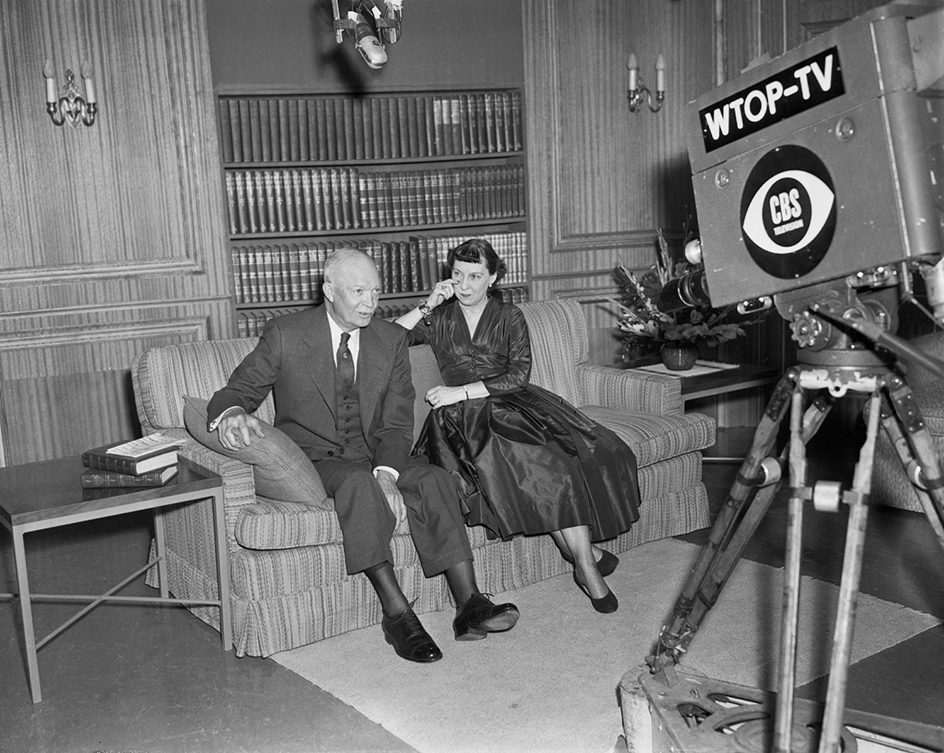
Eisenhower had several advantages over Stevenson. For example, the new medium of television transmitted Eisenhower’s kindliness and dignity far more effectively than Stevenson’s intellectual wit. In addition, many Americans blamed the Democratic Party for giving the federal government far too great a role in people’s lives. Other Americans believed charges that the Democrats had allowed Communists to gain high government posts. Perhaps most importantly, many people admired Eisenhower’s experience and integrity. They believed that he would restore government to its proper role and raise a mighty shield against Communism.
Loading the player...Eisenhower's inaugural speech
In the election, Eisenhower received almost 34 million popular votes, 55 per cent of the ballots cast. The Republicans also won control of both houses of Congress.
Eisenhower’s first administration (1953-1957)
Eisenhower’s methods.
As president, Eisenhower delegated wide powers to aides. “This idea that all wisdom is in the president, in me, that’s baloney,” he said. Eisenhower made each Cabinet officer and White House assistant responsible for an area of government affairs. He chose officials for their managerial ability and strong convictions.
Shortly after Eisenhower took office, the Department of Health, Education, and Welfare (now the Department of Health and Human Services) was created. Oveta Culp Hobby became the first secretary of the department. Her appointment raised the number of Cabinet members to 10.
“Modern Republicanism”
was Eisenhower’s term for his legislative program. In domestic affairs, he asked for a reduction in government spending and for better federal management policies. In foreign policy, he emphasized close cooperation with the nation’s allies.
In working with Congress, Eisenhower used his personal influence only for a few programs he thought essential. He was often unable to rely on the Republicans in Congress to get legislation passed because they were divided on many issues. He therefore depended on the leadership of the Democratic opposition.
By 1956, the federal government’s revenues exceeded its expenses, and a small surplus appeared in the U.S. Treasury. Eisenhower’s emphasis on economy also led to a reorganization of the armed forces. The “new look” involved fewer conventional forces but more nuclear weapons. Congress passed several other major fiscal reforms. It gave the nation’s tax system a thorough overhaul, broadened the social security system, and increased the minimum wage to $1 an hour.
Despite his desire to cut costs, Eisenhower approved several multibillion-dollar public works programs that he believed would strengthen the economy. One was the St. Lawrence Seaway, a waterway that opened the Great Lakes to ocean ships. It was begun in 1954 and completed in 1959. Another was the interstate highway system, begun in 1956. A proposal to build a dam on the Colorado River drew wide criticism and was rejected.
Challenges from the Old Guard
occupied much of the president’s attention. One of the most troublesome of these conservative Republicans was Senator Joseph R. McCarthy of Wisconsin, who headed a subcommittee looking for Communists in the government. He had gained national attention in 1950 by charging—with no evidence—that there were Communist spies in the State Department and the Army.
McCarthy also attempted to ban books he considered to be written by Communists. He tried to keep such books out of the State Department libraries in many countries. In a June 1953 speech at Dartmouth College, Eisenhower urged his young audience, “Don’t join the book burners.” But Eisenhower refused to publicly criticize McCarthy, claiming it was beneath the dignity of the presidency to do so. He explained that he would not “get into the gutter with that guy.” As Eisenhower expected, the Senate soon curbed McCarthy. It condemned him in December 1954 for conduct unbecoming a senator. McCarthy’s influence quickly declined. Loading the player...
Dwight Eisenhower on censorship
Another Old Guard member challenging the president was Senator John W. Bricker of Ohio. In January 1953, Bricker proposed a constitutional amendment that would require Senate consent for international agreements made by the president. Eisenhower opposed any measure that would reduce the president’s power to conduct foreign policy, and his supporters defeated the amendment.
The Republican Party lost control of both houses of Congress in the midterm election of 1954. For the rest of his presidency, Eisenhower had to work with a Democratic-controlled Congress. This situation made it difficult to win support for his programs.
Foreign affairs.
Although Secretary of State John Foster Dulles appeared to direct U.S. foreign policy, Eisenhower himself set the course. A month after his election as president, Eisenhower kept his promise to visit Korea. The trip failed to bring immediate results. A truce was finally signed on July 27, 1953.
Working behind the scenes, Eisenhower used the Central Intelligence Agency (CIA) to take action against suspected Communist-sponsored governments. The CIA helped overthrow such governments in Guatemala and Iran during the mid-1950’s.
Eisenhower rejected several requests from his advisers that he use nuclear weapons during crises. But the possibility that the United States might use such weapons probably helped bring about the truce in Korea.
The president urged that the world harness nuclear power for peaceful use instead of employing nuclear weapons for war. In a major speech to the UN in December 1953, he suggested that nations contribute nuclear materials to a UN agency that would develop peaceful uses of nuclear energy. His program was called Atoms for Peace. The delegates responded with loud cheers never before heard in the UN. The International Atomic Energy Agency developed from Eisenhower’s proposal.
The death of Soviet Premier Joseph Stalin in March 1953 seemed to clear the way for better Soviet-American relations. In July 1955, the leaders of France, the United Kingdom, the Soviet Union, and the United States attended a so-called summit meeting in Geneva, Switzerland. Eisenhower proposed an arrangement called Open Skies, under which the United States and the Soviet Union would allow air inspection of each other’s military bases. But the Soviets rejected his proposal.
Illnesses.
In September 1955, while on a working vacation in the Rocky Mountains of Colorado, the president suffered a heart attack. He recovered quickly, working from his hospital room by his 65th birthday in October and returning to his desk in December.
The heart attack raised questions about the president’s fitness to run for a second term. But Eisenhower could see no one with sufficient experience to succeed him. In February 1956, he announced that he would seek reelection. In June, just as Eisenhower was beginning to campaign, he had an attack of an intestinal disorder called ileitis that required surgery. Friends and foes alike wondered whether he could continue to carry the burdens of office.
Election of 1956.
The Democrats again chose Stevenson as their candidate for president, with Senator Estes Kefauver of Tennessee as his running mate. A major crisis developed when three traditional U.S. allies—the United Kingdom, France, and Israel—carried out a joint air and land attack on Egypt in October 1956. The attack was designed to regain the Suez Canal, which Egyptian President Gamal Abdel Nasser had taken from its British and French owners three months earlier. The canal links the Mediterranean and Red seas and provides access to the oil-rich Middle East.
Eisenhower was shocked that the U.S. allies had secretly decided among themselves to attack. After the attack, the president moved quickly to end the crisis. He immediately ordered the suspension of planned loans to the United Kingdom. In the UN, the United States proposed a resolution for a cease-fire. Eisenhower also addressed the United States and the world on television. “There can be no law if we work to invoke one code of international conduct for those who oppose, and another for our friends,” he insisted. The United Kingdom and France were outraged over what they called Eisenhower’s betrayal. However, they withdrew their invasion forces when UN troops arrived to replace those forces.
Eisenhower’s handling of the Suez crisis as well as his powers of recovery from illness strengthened the great confidence that American voters had in him. A few days after the speech, the voters went to the polls and awarded Eisenhower an even greater victory than in 1952.
Eisenhower’s second administration (1957-1961)
Life in the White House.
The Eisenhowers’ eight years in the White House was the longest time they had lived in one place. In 1950, they bought a farm in Gettysburg. It was the first permanent home they owned. 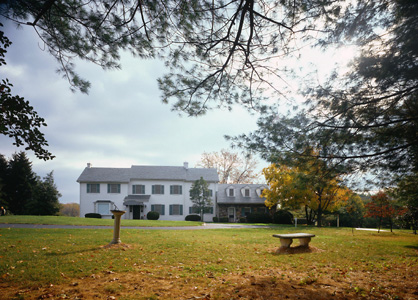
Golf was the president’s favorite recreation, and passers-by could sometimes see him practicing golf shots on a special green that was installed on the White House lawn. Eisenhower also liked to cook. Sometimes he invited friends to a cookout on the White House roof, where he broiled steaks on a charcoal grill.
Civil rights.
The president favored a deliberate, orderly end to racial discrimination against black Americans. But in September 1957, a crisis in Little Rock, Arkansas, wrecked his hopes of proceeding slowly in a push for school integration. Governor Orval E. Faubus of Arkansas defied a federal court order to integrate Little Rock Central High School. Faubus used the Arkansas National Guard to prevent black students from entering the school. Eisenhower then placed the National Guard under federal control and sent a Regular Army unit, the 101st Airborne Division, to enforce the court order and protect the black students. In a televised address, Eisenhower explained that he had acted in order to prevent further civil disorder. 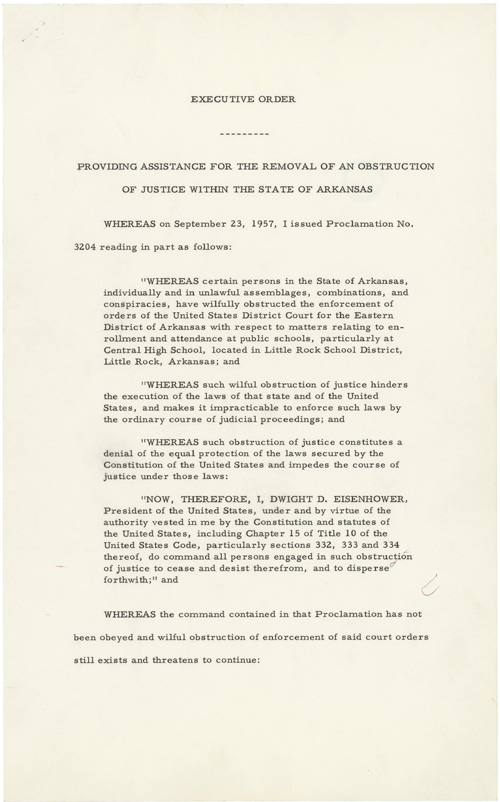
The space age
began on Oct. 4, 1957, when the Soviet Union launched Sputnik 1, the first artificial satellite. On Nov. 3, 1957, the Soviets launched Sputnik 2, a larger satellite that carried a dog as a passenger.
Americans were shocked that the Soviets had beaten the United States in technology, the area of its greatest pride. Many Americans also feared that the Soviet Union might have long-range missiles powerful enough to hit North America. In response, Eisenhower supported two expensive projects that went against his cost-cutting beliefs. One was an all-out effort to quickly catch up to the Soviets in space technology. The other project was to provide federal assistance to schools in support of science education.
The new space program got off to a fast start. On Jan. 31, 1958, the first U.S. satellite, Explorer 1, went into orbit.
Crises in the Middle East and Asia
troubled Eisenhower early in his second term. In 1957, he had proposed, and Congress had approved, a policy called the Eisenhower Doctrine. The policy pledged U.S. financial and military aid to any Middle East nation that asked for help against Communist aggression. In July 1958, Eisenhower used the doctrine to send troops to Lebanon to protect its pro-Western government from rebel forces. This involvement helped restore peace and protect United States oil interests in the region. The troops left in October.
In August 1958, China began shelling the Quemoy and Matsu islands, which were held by pro-Western Taiwan. Eisenhower ordered the U.S. Navy to help convoy supplies from Taiwan to the islands. This aid helped end the serious threat to Taiwan.
Midterm elections.
In June 1958, congressional investigators revealed that Eisenhower’s chief White House aide, Sherman Adams, had received gifts from a Boston businessman who was being investigated by the government. Adams admitted accepting the gifts but denied trying to influence officials in the businessman’s favor. Eisenhower stubbornly refused to dismiss Adams. At the urging of Republicans worried about upcoming congressional elections, Adams resigned in September.
A business recession occurred in 1957 and 1958. The unemployment rate rose to 7.3 percent in July 1958. Even though the economy began to recover by the autumn of 1958, the business downturn contributed to a big Democratic victory in the midterm elections of November 1958. The Democrats increased their majority in Congress enough to override presidential vetoes.
U-2 incident.
Stalin’s successor, Soviet Premier Nikita Khrushchev, agreed to an exchange of visits between himself and Eisenhower and a summit meeting in Paris. Khrushchev came to the United States in September 1959. It was the first visit to the United States by a top Soviet leader. 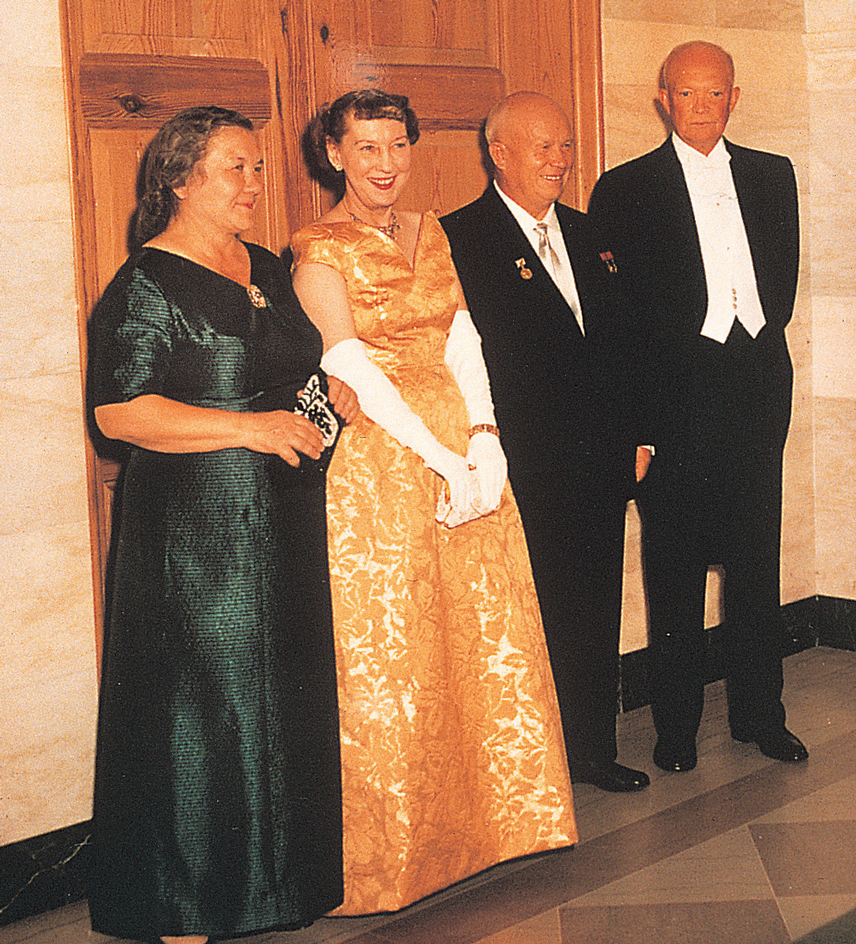
In May 1960, just before Eisenhower left for the Paris summit, the Soviets shot down an American U-2 spy plane over their territory. In Paris, Khrushchev demanded a U.S. apology. When Eisenhower did not apologize, Khrushchev walked out and withdrew his invitation to Eisenhower to visit the Soviet Union.
A break with Cuba
occurred near the end of Eisenhower’s second term. Fidel Castro, who became dictator of Cuba in 1959, made the country a Communist state. In 1960, he seized all property owned by U.S. companies in Cuba. On Jan. 3, 1961, Eisenhower broke off diplomatic relations with Cuba.
Retirement.
Eisenhower was the first president whose term of office was limited by the Constitution. The 22nd Amendment, which became law in 1951, limits a president to two full elected terms. In 1960, the Republicans nominated Vice President Nixon to succeed Eisenhower as president. Nixon lost the election to the Democratic candidate, John F. Kennedy. 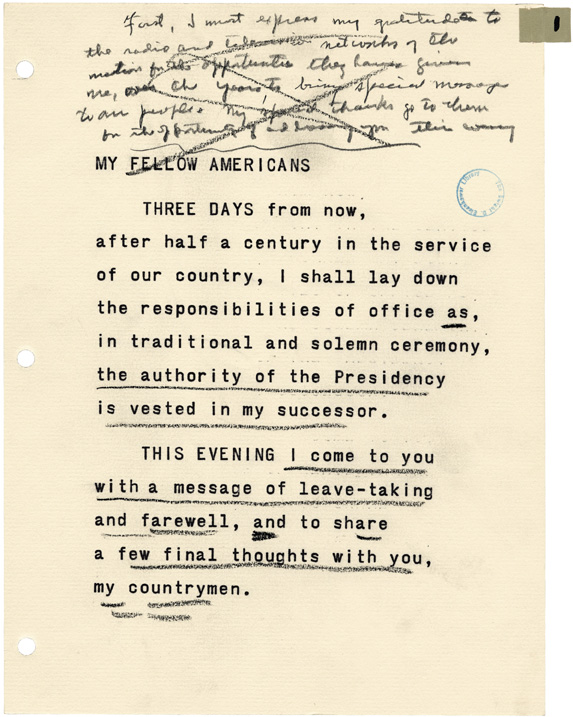
Eisenhower left office in January 1961 and retired to his farm at Gettysburg, where he raised cattle and wrote three books of memoirs. After a series of heart attacks, Eisenhower died of heart failure on March 28, 1969. He was buried in Abilene, where a library with his papers opened to researchers soon afterward. 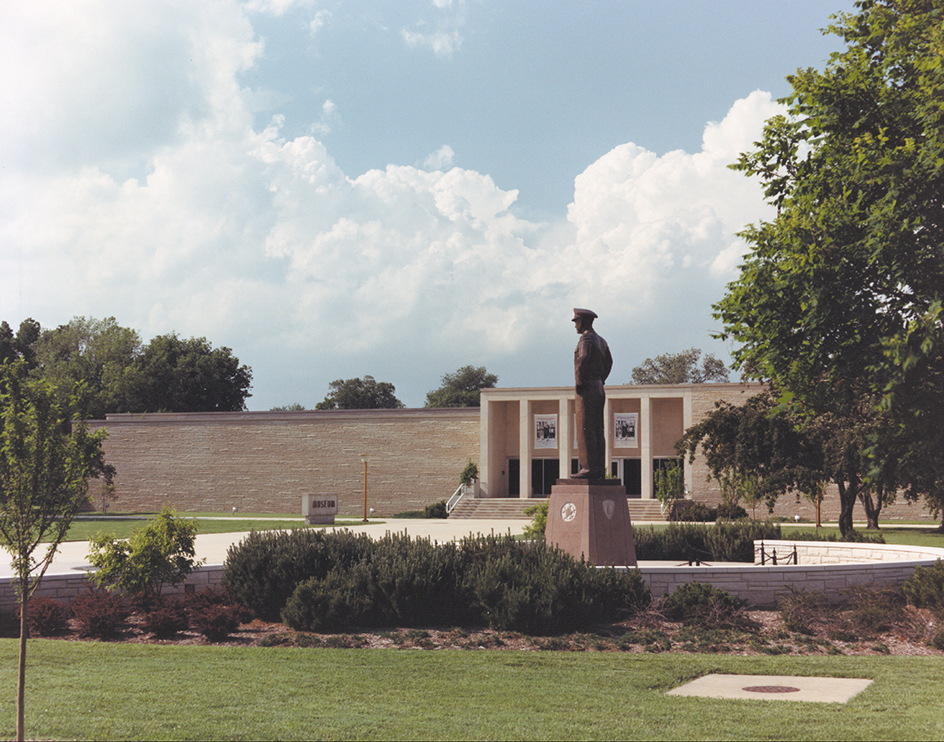
The Dwight D. Eisenhower Memorial, in Washington, D.C., opened in 2020. The memorial, which stands just southwest of the U.S. Capitol, features a sculpture garden with scenes from Eisenhower’s life.
